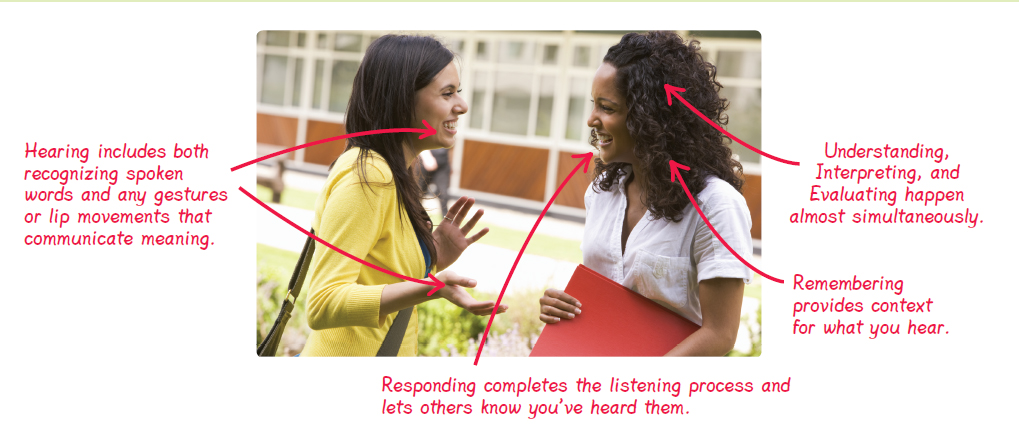Stages of the Listening Process
The process of listening involves six stages: hearing, understanding, interpreting, evaluating, remembering, and responding to others’ communication. As you learn about each stage, consider why it is critical to becoming a more active listener.
Hearing.Listening begins with hearing: physically processing the sound that others have produced, and mentally focusing your attention on it. Hearing occurs when sound waves enter your inner ear, causing your eardrum to vibrate. These vibrations travel along special nerves to your brain, which interprets them as words and sounds. For people who are hearing impaired or deaf, “hearing” means visually noticing that someone else is communicating by seeing either the person’s lips move or the person’s hands gesture in signs (if they are using American Sign Language). In such cases, you can hear with your eyes rather than with your ears.

During this stage of the listening process, the mental side of hearing also begins, as you actively concentrate your attention on the sounds or signs of the other person. If you don’t notice the person’s messages, or if you are distracted and not paying attention, you can’t go on to understand, interpret, evaluate, remember, and respond. This latter scenario often happens when you are multitasking (something we’ll discuss in more detail later) or have a low interest in what someone is saying.
The link between hearing and attention implies a critical truth about listening: if you want to become an active listener, you need to give people your undivided attention when they are speaking (Beall, 2010). To boost your attention level, try to recognize the forces that negatively affect it. Throughout the day, notice how your ability to pay attention naturally strengthens and weakens depending on what’s happening within or around you. For example, when you’re hungry or under a lot of stress, you may have a harder time paying attention to what someone is saying. You can also try to control the factors that make it harder to focus your attention. Avoid situations that call for careful listening when you are overly stressed, hungry, ill, or fatigued—all of which can leave your brain foggy. If you’ve noticed that you have higher energy levels in the morning or early in the week, schedule attention-demanding activities, meetings, and encounters during those times.
THE LISTENING PROCESS

Understanding, Interpreting, and Evaluating.After hearing, the next three stages of the listening process take place almost simultaneously. You begin understanding what you’ve heard; that is, you recognize the literal (or denotative) meaning of the words the other person has said. At the same time, you work on interpreting the full meaning of the message. You identify any implications (or connotative meanings) suggested in the person’s words, and consider what action the person is trying to perform (Is she asking you a question? Issuing a command? Cracking a joke?). To interpret the full meaning of something you’ve heard, you consider nonverbal cues, such as the speaker’s tone of voice, posture, and facial expression. You also take into account the situation and the background knowledge that you and the speaker share.
Even as you’re understanding and interpreting the meaning of a message, you’re also evaluating it: comparing the newly received information against your past knowledge to check its accuracy and validity. Evaluating the message helps you draw conclusions, such as “He’s lying” or “She knows what she’s talking about.”
How do these three stages happen so quickly yet simultaneously? Consider the following example: A student in your class gives a speech on class warfare in politics. At one point in his presentation, he laughs and says, “Most homeless people are that way by choice; why don’t they just get a job!?” Once you hear this comment (you process the sound of his voice and focus your attention on his message), you immediately do three things. You understand the literal meaning of his words, “Most/homeless/people/are . . .” You also interpret his intended meaning: Is he serious? Joking? Being sarcastic? At the same time, you evaluate the validity of what he said: Is it true that homeless people are that way by choice?
This example highlights an important insight regarding how you understand, interpret, and evaluate messages while listening. Your mental processing of messages—and eventual responses—are influenced by your own knowledge, attitudes, beliefs, and values. You don’t listen objectively; instead, your listening is guided by what you already think. For instance, if you believe that homeless people aren’t homeless by choice and that your classmate was ridiculing homelessness, you might take offense. Alternatively, if you think that homeless people choose their own plight, you might find his remark humorous.
How can you use this insight to improve your understanding, interpretation, and evaluation of messages? Use the critical self-reflection and perception-checking skills we discuss in Chapter 2 (pp. 33 and 49). First, practice critical self-reflection while listening. Specifically, get into the habit of asking yourself the following questions: What am I thinking and feeling in response to what is being said? Why am I thinking and feeling this way? How am I listening? and How are my thoughts and feelings affecting my listening—especially my understanding, interpretation, and evaluation of the message? Then, perception-check your conclusions by asking yourself the most important question of all: Is my understanding, interpretation, and evaluation of the message accurate? When in doubt, don’t hesitate to ask the source of the message to verify your assessment (“I may be completely off, but my interpretation of what you said is this. . . . Is that right?”).
Remembering.Once you’ve understood, interpreted, and evaluated a message, it gets stored in your memory. Later, you can call it back into your conscious mind, a process known as remembering (or recalling). Remembering is a crucial part of the listening process. Just imagine not being able to remember anything you’ve heard others say. Merely carrying out daily tasks would be virtually impossible—you couldn’t remember a teacher’s instructions on how to complete an assignment or even what time your roommate said she would be home. When you can accurately recall information after you’ve heard, understood, interpreted, and evaluated it, then you’ve successfully listened to the message (Thomas & Levine, 1994). Indeed, almost every scientific measure of listening uses remembering to measure listening effectiveness.
How can you boost your ability to remember? One way is to use mnemonics, devices that aid memory. Mnemonics are abbreviations, words, simple phrases, ideas, or images associated with what you’re trying to recall. Alternatively, you might think of an image, an idea, or a song that goes with what you’re trying to remember. When creating mnemonics, follow two simple rules: keep it simple, so the information is easy to remember, and repeat the device often, so you lock it down. For instance, when Steve teaches yoga classes, he needs five items: music to accompany and inspire the class, water to stay hydrated, keys to open the stereo system and equipment room at the health club, his yoga mat, and his book with choreography notes. For the first year he taught, however, he would inevitably forget one of these items, causing chaos before his classes. Finally, after much frustration, Steve created a simple mnemonic: “music-water-keys-mat-book.” He said this again and again until it was firm in his mind. Now, every time he has to teach, he says “musicwaterkeysmatbook” out loud to himself before leaving his house—then checks to make sure he has each item.
Responding.The outcome of listening is responding—communicating your attention and comprehension to the speaker. Skillful listeners do more than simply attend and comprehend; they convey the results of their listening to speakers by using verbal and nonverbal behaviors known as feedback. Scholars distinguish between two kinds of feedback: positive and negative.
When you use positive feedback, you look directly at the person who is speaking, smile, position your body so that you’re facing him or her, and lean forward. You might also offer backchannel cues. These are verbal and nonverbal behaviors, such as nodding and making comments (“Uh-huh,” “Yes”), that signal that you’re paying attention to and comprehending specific comments. All of these behaviors combine to show speakers that you’re listening.
In contrast, people who use negative feedback send a very different message—namely, that they’re not listening to the speaker. Negative feedback behaviors include avoiding eye contact, turning your body away, looking bored or distracted, and not using backchannel cues.
Feedback can have a powerful effect on speakers. For example, if you’re giving a presentation, receiving positive feedback from your listeners can enhance your confidence, generate positive emotions within you, and convince you that your audience members are skilled listeners (Purdy & Newman, 1999). Negative feedback can cause you to hesitate, make mistakes, or stop talking in order to figure out why your audience members aren’t listening.